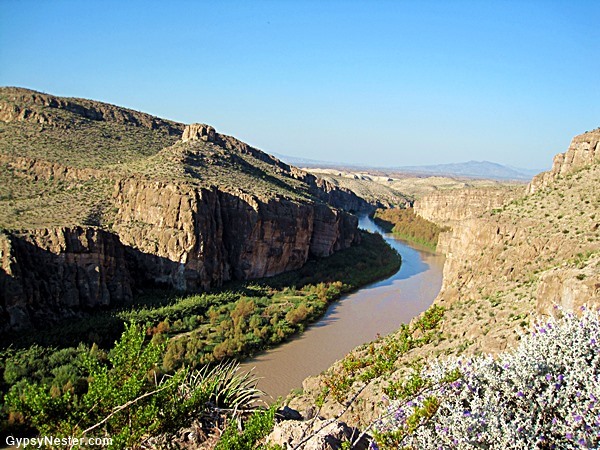 One of the many attractions of our national parks is the chance to get away from it all.
One of the many attractions of our national parks is the chance to get away from it all.
With that in mind, I planned to take a trip with my sister to one of America’s most remote areas, Big Bend National Park.
She had never heard of it, and I was only vaguely familiar, so we did a little research and decided to load up the camper and give it a try. Boy, are we glad we did.
Not that I’ve been to every park, but I’ve been to a bunch and I would rate this one near the top of the list, right up there with Yellowstone, Grand Canyon, and Yosemite.
 The name comes from its location along a huge arc in the Rio Grande River in West Texas, but what we saw as we drove into the park was not what we ever expected to find in in The Lone Star State.
The name comes from its location along a huge arc in the Rio Grande River in West Texas, but what we saw as we drove into the park was not what we ever expected to find in in The Lone Star State.
There were mountains, I mean real, big, mountains, rising high out of the seemingly endless desert.
Millions of years ago faults and plate tectonics thrusted the area up and formed the Chisos Mountains which stand right in the center of the park.
But Big Bend is huge, so we had mapped out a plan to see it in sections. This meant that the peaks would have to wait while we explored the west side.

In this isolated region services are scarce, so we decided to stay our first few days just outside the park boundary in the only civilization to be found for miles and miles, the tiny town of Terlingua.
Even though the population as of the most recent census was a whopping 58, at least we knew that we would have fuel and supplies available before we headed into the wilderness of the park.
We arrived early in the afternoon and set out for our first taste of the park by taking a drive, making a loop around the western portion of the park. In this vast section a vehicle is by far the best way to experience the landscape because there is so much ground to cover.
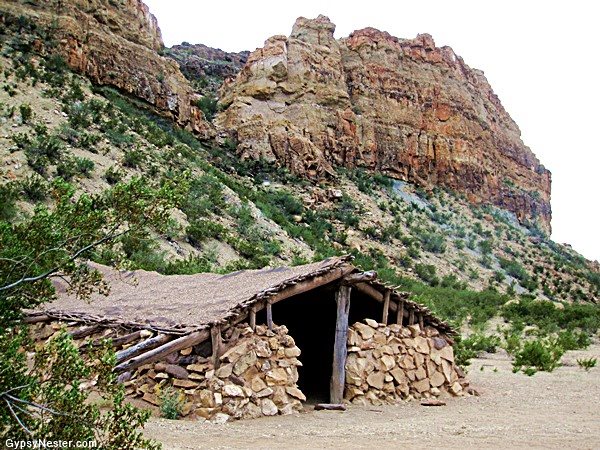
We started heading south on Old Maverick Road and soon came upon an old structure on the side of the road.
The map identified it as Luna’s Jacal, named for Mexican pioneer farmer Gilberto Luna. We were intrigued to find that even in this hostile environment settlers scratched out a living.
The jacal, an adobe house typical to this part of the southwestern United States and Mexico, was built about 1890. It was a style of building that settlers adopted from the natives, and this one has been preserved well enough to be placed on the National Register of Historic Places.
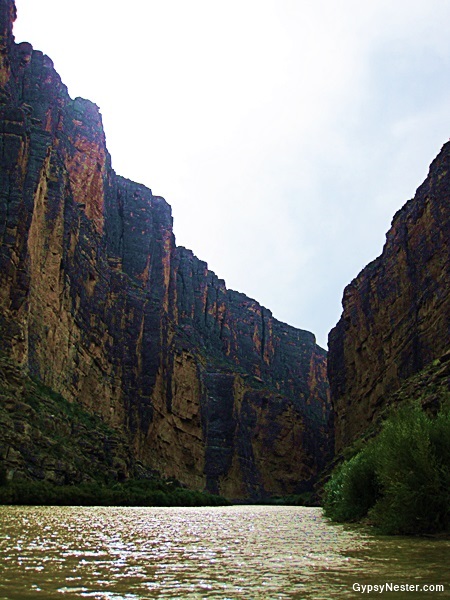
A little farther and we came to an even more unexpected sight, Santa Elena Canyon.
This is a spot where the Rio Grande has cut fifteen hundred foot sheer cliffs into the limestone. The stark walls seemed almost unreal, so I had to go in for a closer look.
Going in required wading through a muddy arm of the river, which meant my shoes had to stay behind.
My lack of footwear came back to haunt me when the trail up to the lookout became covered with sharp rocks that forced me, or at least my feet, to retreat.
It would have been a good time to have some all-terrain sandals like the ones reviewed in this article.
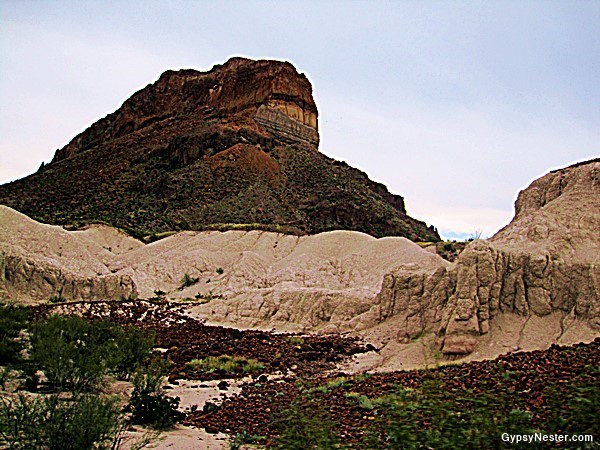 Moving on, we took the Ross Maxwell Scenic Drive north through the geologic formations in Tuff Canyon. Tuff is volcanic ash that has solidified through the ages, but is still very soft and erodes easily.
Moving on, we took the Ross Maxwell Scenic Drive north through the geologic formations in Tuff Canyon. Tuff is volcanic ash that has solidified through the ages, but is still very soft and erodes easily.
The bizarre formations left behind reminded us a lot of the Badlands in South Dakota, although not nearly as large.
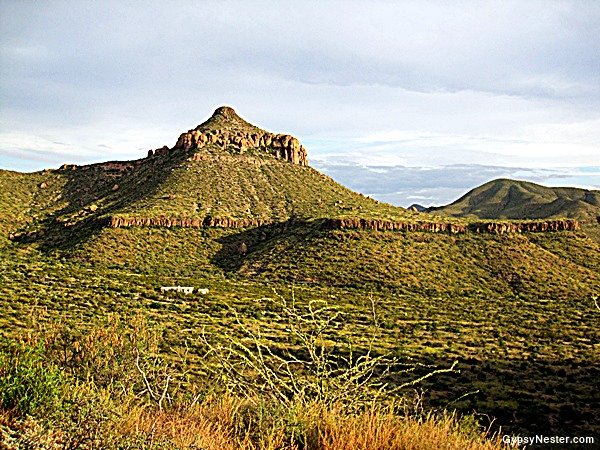
Just past a pair of buttes known as Mule Ears we found another abandoned settlement, the Homer Wilson Ranch.
This was once one of the largest ranches in Texas, and acquiring it in 1942 was instrumental in the formation of the park.
We were surprised to see these outposts in this harsh environment, but it sits in a valley with runoff from the mountains that creates somewhat of an oasis in the heart of the Chihuahuan Desert.
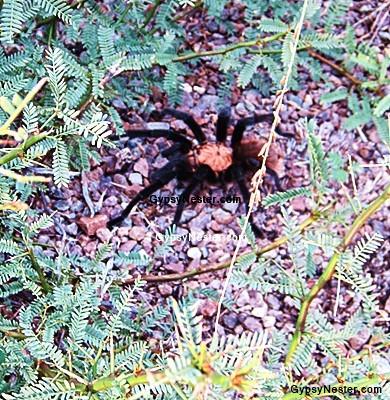
As the sun began to set, we saw several huge black spiders crossing the pavement.
I had to jump out for a close up photo of a Tarantula, which other than birds was the only animal we saw that day.
It seemed like it might have been a rare sighting, but it turned out that we saw these giant arachnids out on the roads every evening.
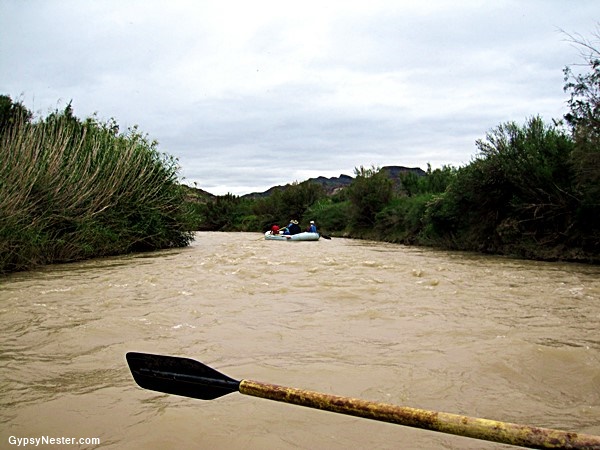 The next day we met up with a group for a rafting expedition down the Rio Grande. The trips can range from half a day to a week, but we just wanted to get our feet wet so to speak, so we only signed up for the morning.
The next day we met up with a group for a rafting expedition down the Rio Grande. The trips can range from half a day to a week, but we just wanted to get our feet wet so to speak, so we only signed up for the morning.
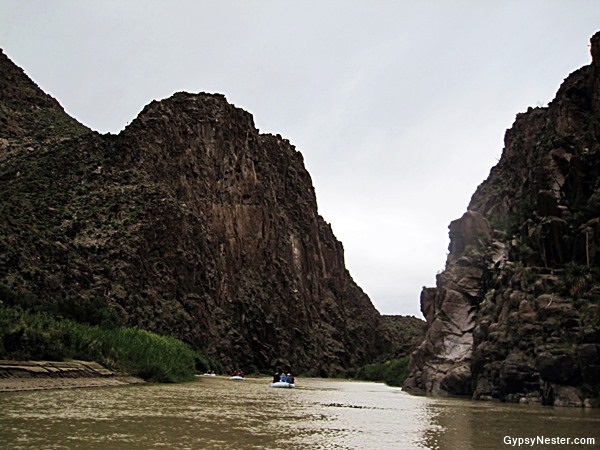
Our river experience we would not be in the national park, although the longer trips do go through, we would be in Big Bend Ranch State Park to the west.
As one might expect, the canyons in the state area are less spectacular, but much more accessible, since a paved road parallels the river.
We floated serenely through the valley, under cliffs, and along lush shoreline, even getting a chance to touch Mexico on the southern side of the river from time to time. Half the day flew by, and before we knew it we were pulling our rafts out and loading them back on the trailers.
In the afternoon we stopped off to check out the Terlingua ghost town. It dates back to the 1880s, when the minerals terlinguaite and cinnabar were discovered. These form the ore that mercury is extracted from, and soon a booming mining community sprouted up.
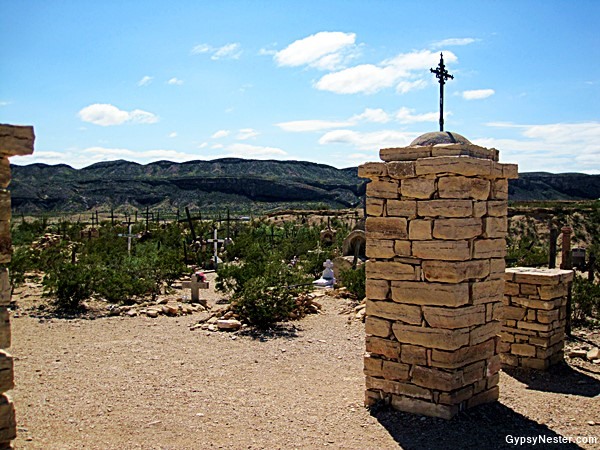
Remnants of many stone houses remain, but for us the cemetery was the most interesting. While perusing the headstones we began to notice that an exceedingly abnormal number of the deceased men died in their early thirties.
For some reason, that seemed to be the most common life expectancy for male residents until after the mines closed post World War II.
We couldn’t find anything that mentioned it, either in the town or online, but it didn’t take a genius to surmise that mercury poisoning was the most likely cause.
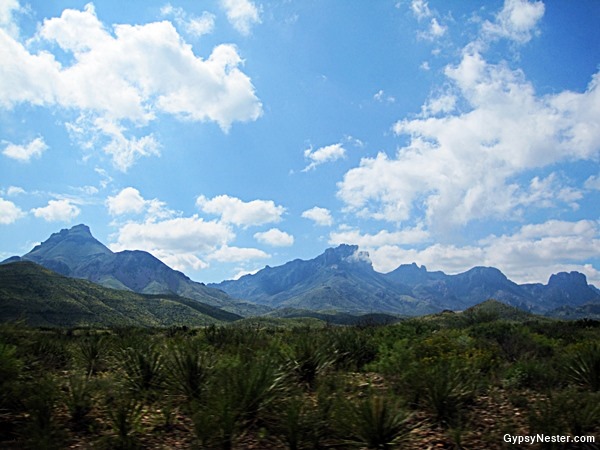 Working our way into the park meant that Chisos Basin would be our next destination. The basin is surrounded by the Chisos Mountains, the only range in the US to be completely inside of a national park.
Working our way into the park meant that Chisos Basin would be our next destination. The basin is surrounded by the Chisos Mountains, the only range in the US to be completely inside of a national park.
There is an amazing campground in the basin, but we couldn’t take advantage of it because it was not accessible to our large RV. Most of the campers had chosen tents. Had we known, we could have planned ahead and checked out Gearweare for our best options.
In this alpine area, with peaks rising as high as 7,825 feet above sea level, our feet would be the preferred mode of transport as we explored some of the twenty miles of trails. We warmed up on the Chisos Basin Loop Trail, which took us two miles around the bottom of the valley.
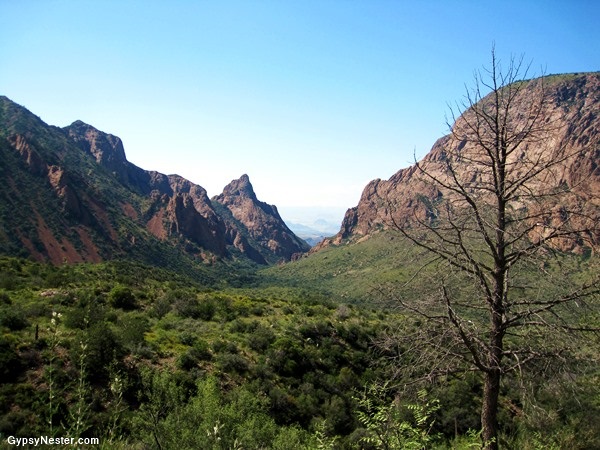
With that under our belts, we felt prepared to tackle the more difficult Window Trail. Most of the three miles leading to the edge of the mountains was, let’s say, a walk in the park, but the last few hundred yards were a real doozy.
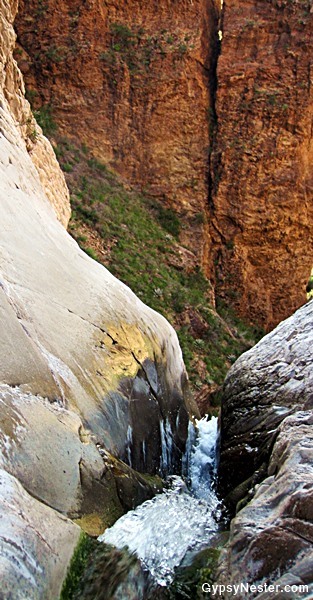 The trail becomes one with Oak Creek as it descends into a Canyon, then abruptly pours over a drop known as the Window.
The trail becomes one with Oak Creek as it descends into a Canyon, then abruptly pours over a drop known as the Window.
We had to carefully, make that very carefully, pick our way toward the final edge where the rock walls form a frame for a panoramic desert view.
But what goes down must come back up, so the hike back was a bit of a challenge, especially late in the day. With the sun getting down behind the peaks we scurried to make it back in time to drive to the Rio Grande Village Campground for the night.
The “village” is on the far eastern edge of the park, and stretches the definition a bit. It is actually just a small store and a campground. I guess in these parts that passes for at least a village, maybe even a city.
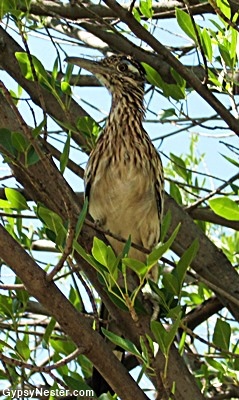
In this section of the park the landscape has a classic southwestern look about it. We almost expected to see the roadrunner running down the road.
Then, much to our surprise, we saw him in a tree, fortunately with no coyote to be found.
It seemed that this was our morning for spotting animals. Most shy away from the heat of the day, so we were lucky to be up early enough to catch a small herd of javelina.
These guys certainly look like wild pigs, but they are actually Collared Peccary, a cousin on the family tree.
Watch a herd of javelinas:
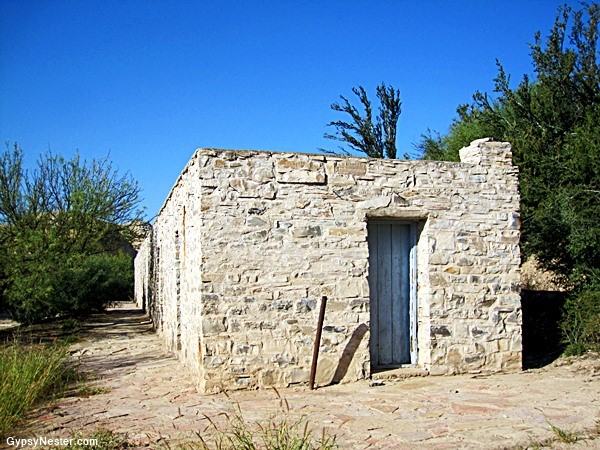 Passing the pigs, we set out on the Hot Springs Historic Trail to see one of the first tourist attractions of Big Bend.
Passing the pigs, we set out on the Hot Springs Historic Trail to see one of the first tourist attractions of Big Bend.
Back in 1909, J.O. Langford heard tell of a spring with healing powers. In need of a remedy himself, as well as wanting to share the miraculous waters with others, he settled the land under the Homestead Act and proceeded to build a motel and a bathhouse for guests.
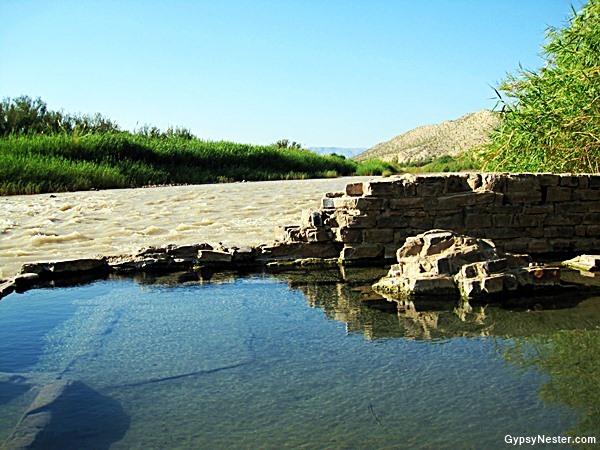
The motel remains standing, but all that is left of the riverside bathhouse is the foundation, which is filled with the 105° water that still flows from the spring.
A little farther downstream, we followed the Boquillas Canyon trail to another astonishing gorge. This dramatic cut forms a perfect bookend for the park opposite the Santa Elena Canyon on the western edge.
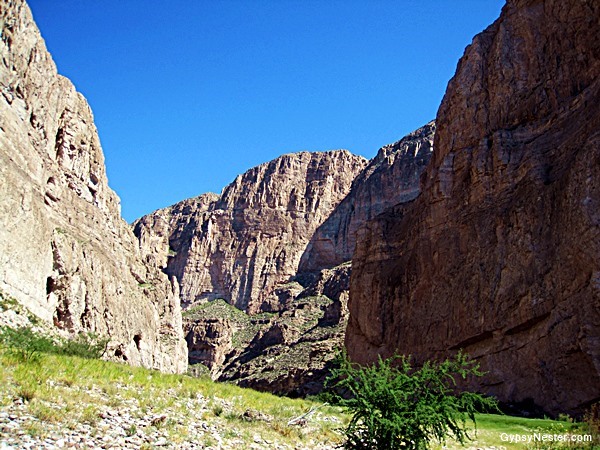
Having covered nearly the entire park, at least the areas accessible without requiring days of backpacking or rafting, we were most impressed by how every part of Big Bend is so different.
The landscapes go from lush and green near the water to arid desert not far away. We found alpine forests within a few miles of cactus and scrub, and astounding stone chasms that almost immediately give way to placid river banks.
Our memories will be of being pleasantly surprised almost every time we turned a corner or crested a hill.
David, GypsyNester.com
This post contains sponsored links.



Highly descriptive post, I enjoyed that.
This info is invaluable. Where can I find out more?
Hello everyone!Thanks for sharing useful information, I too try this application on my site.It was really useful., Lovely pictures, You have great workout article ! its really useful for me and also for your blog visitor
I found your website from Google and also I have to claim it was a terrific
discover. Many thanks!
I am sad to say that we live in Texas and have never been there! It’s just so far away! Some travelers, huh?
Hope you can make the trip sometime Greg, it is certainly worth it. While you are out there you could check out the mysterious Marfa lights too. https://gypsynester.com/marfa-my-dear/
Wow! What an awesome place to enjoy the beauty of nature, I really liked your pics. Thanks for sharing this unique experience with us.